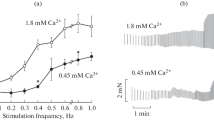Summary
The curve of the second derivation of the force to the time derived under isometric condition from papillary muscle of the guinea pig and from strips of ventricular muscle (of frog, axolotl, turtle, calf) shows a pronounced minimum during relaxation. The time from the beginning of the mechanogram to the minimum corresponds to the duration of the action potential in each experiment. The finding is discussed with respect to electro-mechanic coupling during muscle contraction.
Zusammenfassung
In der zweiten Ableitung nach der Zeit des isometrischen Mechanogramms vom Papillarmuskel des Meerschweinchenherzens sowie vom Herzstreifen des Kalbes, Frosches, Axolotls und der Schildkröte tritt nach dem mechanischen Gipfel ein Minimum auf. Die Zeitdauer vom Beginn der Kontraktion bis zum Erscheinen dieses Minimums ist die gleiche wie die des Aktionspotentials vom Beginn der Depolarisation bis zur völligen Repolarisation. Es wird eine Steuerung des mechanischen Prozesses durch den Membranprozeß diskutiert.
Similar content being viewed by others
Literatur
Bleichert, A., u. H. Reichel: Die Hemmung der Erschlaffung beim Herzmuskel des Kalt- und Warmblüters. PflÜgers Arch. ges. Physiol. 276, 242–249 (1962).
—— —— u. H. Ballhorn: Über elektrisch ausgelöste Kontrakturen am Skeletmuskel des Frosches. Pflügers Arch. ges. Physiol. 282, 225–231 (1965).
Dudel, J., u. W. Trautwein: Das Aktionspotential und Mechanogramm des Herzmuskels unter dem Einfluß der Dehnung. Cardiologia (Basel) 25, 344–362 (1954).
Kavaler, F.: Membrane depolarization as a cause of tension development in mammalian ventricular muscle. Amer. J. Physiol. 197, 968–970 (1959).
Morad, M., u. W. Trautwein: Die Bedeutung des Aktionspotentials für die Dauer und Amplitude der Kontraktion des Herzmuskels. Pflügers Arch. ges. Physiol. 291, R 8 (1966).
Reichel, H., F. Zimmer u. A. Bleichert: Die elastischen Eigenschaften des Skeletund Herzmuskels in verschiedenen Phasen der Einzelzuckung. Z. Biol. 108, 188–195 (1956).
Trautwein, W., u. J. Dudel: Aktionspotential und Mechanogramm des Warmblüterherzens als Funktion der Schlagfrequenz. Pflügers Arch. ges. Physiol. 260, 24–39 (1954).
—— —— Aktionspotential und Mechanogramm des Katzenpapillarmuskels als Funktion der Temperatur. Pflügers Arch. ges. Physiol. 260, 104–115 (1954).
Author information
Authors and Affiliations
Rights and permissions
About this article
Cite this article
Rumberger, E. Über Korrelationen zwischen der Aktionspotentialdauer und dem zeitlichen Verlauf der Erschlaffung beim Herzmuskel des Warm- und Kaltblüters. Pflügers Arch. 301, 70–75 (1968). https://doi.org/10.1007/BF00412419
Received:
Issue Date:
DOI: https://doi.org/10.1007/BF00412419



